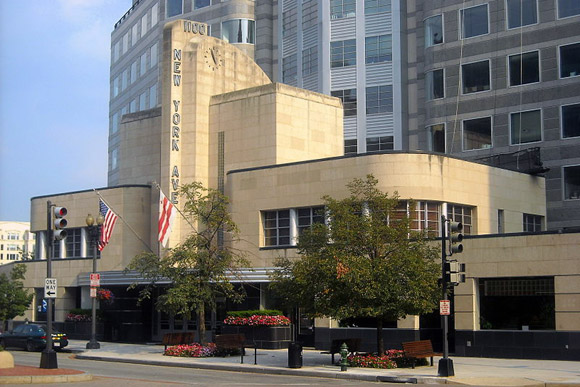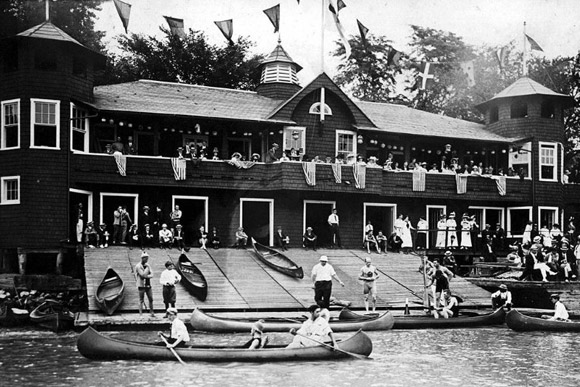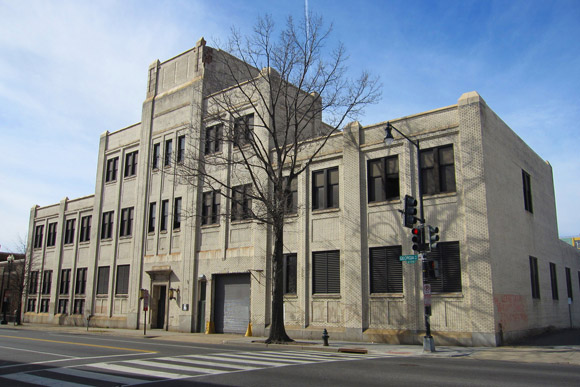When cookie-cutter buildings replace historic ones, something is lost. Here's how preserving D.C.'s landmarks can enrich our neighborhoods.
There’s a distinct difference between the design of the high-rise office building that sits at 1100 New York Avenue NW and its pavilion entrance. While the first is modern, the second has a 1930’s, art-deco feel. That’s because the entrance once operated as the Greyhound Bus company’s Super Terminal, which was completed in 1940.
While D.C. transplants may be more familiar with the more modern swath of New York Ave.—which includes the new City Center development with high-end retail stores and restaurants—longtime Washingtonians can recall the major transportation hub on New York Avenue. In fact, many still reference the site as “the old Greyhound terminal,” says Peter Sefton, chair of the DC Preservation League’s (DCPL) Landmark Committee. “People say it all the time—it’s a place-making type of landmark. It’s not a bus terminal anymore but it still has that identity.”
Lists such as the National Register of Historic Places and the D.C. Inventory of Historic Sites were formed to preserve landmark buildings. Properties on the list are acknowledged and protected from being completely demolished because of their cultural significance.

Structures like the former Greyhound terminal add character to neighborhoods, especially during a time when cookie-cutter hotels, apartment buildings and pubs spring up throughout the city. When torn down, pieces of history are also stripped from the city; when restored, they can act as catalysts for neighborhood revitalization.
When the Atlas Theater on H St. Northeast was transformed into the Atlas Performing Arts Center in 2006, the surrounding commercial district was deserted. Today, the corridor that bustles with bars and retails shops is often referred to as the Atlas District.
The Atlas has become a poster child for what happens when historic buildings are restored in desolate areas, says Sefton.
A lover of theaters, he also advocated to put the Strand Theater, located in Northeast’s Deanwood neighborhood, on the DCPL’s ‘
Most Endangered Places’ list.
Formed in 1996, the list is often a precursor to buildings being named historic sites.
The Strand, located at 5131 Grant Road, NE, was placed on the preservation list in 2007, then placed on the National Register of Historic Places. Redevelopment or restoration of the property, however, has yet to occur.
 The Strand Theater
The Strand Theater
“It’s been very disappointing what’s gone on with the [Strand] Theater,” says Sefton. “We understood that with the [historic designation] that a redevelopment project would follow pretty fast, and that hasn't happened.”
The preservation of the theater, which opened in 1928, is significant to the history of entertainment in the city. When it began operation, segregation laws banned blacks from entering many establishments.
“It was a pretty big deal that there was finally a theater where African Americans could go to the movies, east of the Anacostia,” said Sefton.
As the first east-of-the-river motion picture theater, the Strand helped shape the Deanwood community as a destination for people of color. Built by impresario A.E. Lichtman, the property included stores, a dance hall and poolroom, and was located near Suburban Gardens, the only African-American community amusement park in the city.
While researching the theater’s history, Sefton met elderly Washingtonians with vivid memories of outings with friends and date nights at Strand.
“It was a big part of the socialite [scene] in the Deanwood community for years,” says Sefton. Most often, the theater showed westerns and serial films and sold popcorn to moviegoers. “It was not a very fancy theater, but it was a big part of people's lives.”
The Strand eventually closed in the 1970s and reopened for a short stint as a convenience store. Today, it stands vacant and deteriorating, supposedly part of D.C's plans for a town center in the heart of Deanwood.
Other endangered buildings seem to have more potential for development.
Jim Ross, vice president of the
Washington Canoe Club, believes the Georgetown waterfront facility is a treasured landmark.
“The structure is original from when our founding members first constructed it in 1904,” says Ross. “It has remained the same for 110 years, which is pretty rare in Washington, D.C., especially on the river.”
For over a century, the club has been a training center for competitive canoeing and kayaking, producing numerous national champions and Olympic medalists.
The club’s partnership with Team River Runner engages disabled veterans, while collaborations with the YMCA and DC Kids offer life-changing opportunities for youth.
“[It’s] a great opportunity to show [youth] that D.C. has this really vibrant river that you can get out on—you don’t just have to take a bridge to cross over it and have it be an annoyance,” says Ross.
Youth who learn to canoe and kayak at the center have also earned spots on national and international teams and have paddled throughout destinations in Europe during summer breaks.

While the club's primary focus may be on the water, the building itself is also structurally significant. Designed by Georges P. Hales, the fixture is an example of shingle-style architecture. The interior is decorated with a frieze by Felix Mahony, a cartoonist for the Washington Star and the founder of the National Art School, done in 1910 and restored in 1981. Its "flow through" design has survived floods and ice jams with little damage.
The Canoe Club was added to the endangered places list in 2012 by its board of directors. While the club was still in operation, it was in desperate need of internal and external rehab.
Through a partnership with the National Park Service and a fundraising campaign, Ross hopes to secure a long-term lease for the site and provide substantial upgrades.
Further north in town, at 2146 Georgia Avenue, NW, the site of the former Bond Bread Factory has also remained unoccupied for decades. Built in 1930, it was one of many large bakeries that occupied the neighborhood.
This structure in particular became known for its state-of-the-art design by bakery architect C.B. Comstock.

“It’s basically an industrial building, yet on Georgia Avenue, its front facade is a very distinctive late art deco influence design and it’s white brick to emphasize the cleanliness of the bread that was made in the factory,” says John DeFerrari, who nominated the factory to the endangered list in 2012. “The industrial aesthetic of the building was something that was very unique to the time and demonstrated kind of a civic pride of this factory—it’s not merely a utilitarian structure, it's an important part to of the community.”
For years, the Bond Bread Factory rivaled the neighboring Wonder Bread Factory for business. It closed in 1971.
“It was sold to the D.C. government, that opened it … as a mini-City Hall, a place where people could get basic services from the city—so it has that heritage, as well,” says DeFerrari.
In 2008, the factory was acquired by Howard University, which intended to develop it into a mixed-use facility for students. However, a contract to get the project underway was terminated in June 2013.
"It's never a good thing for any building to deteriorate physically, and we certainly don't want it to stand empty for a lot longer because it would jeopardize the building's future," says DeFerrari. "So, hopefully, a new redevelopment proposal can be made that would preserve the key elements of the building and still make it useful for a new purpose."
A mix of interesting, historic buildings is one element that makes a neighborhood great. To hear about this and many other elements of great neighborhoods --come to our event Dec. 2.